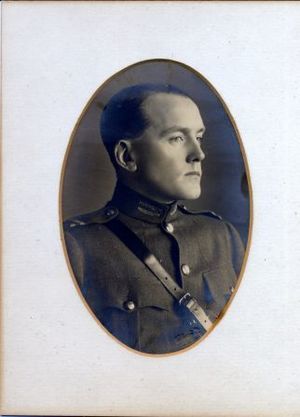Gearóid O'Sullivan facts for kids
Quick facts for kids
Gearóid O'Sullivan
|
|
|---|---|
 |
|
| Teachta Dála | |
| In office August 1927 – July 1937 |
|
| Constituency | Dublin County |
| In office May 1921 – August 1923 |
|
| Constituency | Carlow–Kilkenny |
| Personal details | |
| Born |
Jeremiah O'Sullivan
28 January 1891 Skibbereen, County Cork, Ireland |
| Died | 25 March 1948 (aged 56) Dublin, Ireland |
| Spouses |
|
| Children | 4 |
| Alma mater | St Patrick's College of Education |
| Military service | |
| Branch/service |
|
| Rank | Adjutant-General |
| Battles/wars | |
Gearóid O'Sullivan (born January 28, 1891 – died March 25, 1948) was an important Irish figure. He was a teacher, a scholar of the Irish language, and a high-ranking army officer. He also worked as a lawyer and was a politician for the Sinn Féin and Fine Gael parties.
Contents
Early Life and Education
Gearóid O'Sullivan was born Jeremiah O'Sullivan in Coolnagurrane, near Skibbereen, County Cork. He was the fourth son of Michael and Margaret O'Sullivan. Even as a young boy, people noticed how smart he was. He was chosen to help other students and even check on the teachers.
He later studied at a school in Skibbereen. There, he met people who helped him get more involved in the Irish nationalist movement. This movement aimed for Ireland's independence. He also grew to love Irish language and culture even more. One person he met was James Duggan, who was a friend of Gearóid's cousin, Michael Collins. Gearóid joined the Gaelic League at age ten, which promoted the Irish language.
In 1909, Gearóid started training to be a teacher at St Patrick's College of Education. He began teaching in 1911. He soon moved to Dublin and taught at St Peter's National School. He joined another branch of the Gaelic League and became a leader. He taught Irish to many people. He also trained with the Irish Volunteers, a group working for Irish independence. Here, he met Michael Collins again.
The Easter Rising
In November 1913, O'Sullivan joined a special company of the Irish Volunteers. He was also a member of the Irish Republican Brotherhood (IRB). This was a secret group that wanted to free Ireland from British rule.
During the 1916 Easter Rising in Dublin, Gearóid O'Sullivan played a key role. He was just 25 years old. He famously raised the Irish Flag over the General Post Office (GPO). This happened while fierce fighting took place around the GPO. The leader of the rebellion, Seán Mac Diarmada, chose O'Sullivan to be his assistant. Another leader, Patrick Pearse, gave him the honor of raising the flag.
After the Rising, he married Maud Kiernan. They had three daughters and one son. After Maud passed away at age 40, he married Mary Brennan.
Fighting for Irish Independence
After the Easter Rising, O'Sullivan was held in a prison camp in Wales called Frongoch. Many Irish rebels, including Michael Collins, were also held there. Unlike the leaders of the Rising, they were not executed. In prison, O'Sullivan and Collins became very close friends. O'Sullivan, who was a scholar, even helped Collins improve his Irish language skills.
When they were released in December 1916, O'Sullivan and Collins continued their work for Irish freedom. The Irish Volunteers became the IRA in 1919. O'Sullivan was arrested again and went on a hunger strike. This led to his early release. In 1920, Michael Collins asked O'Sullivan to take his place as the Adjutant General of the IRA. This was a very important and dangerous job. O'Sullivan was one of Collins's closest friends and helped him with many secret missions. There was even a large reward offered for O'Sullivan's capture.
In 1921, O'Sullivan was elected as a Teachta Dála (TD), which means a member of the Irish parliament. He represented the area of Carlow–Kilkenny. He was re-elected in 1922.
During the Irish Civil War, he served as a top officer in the National Army. This army supported the new Irish Free State. In 1922, he was appointed to the Army Council, a group of leaders for the National Army.
Life After the Wars
After the Civil War, Gearóid O'Sullivan left the army. He became a lawyer, called a barrister, and focused on his family.
In 1927, a politician named Kevin O'Higgins was killed. O'Sullivan was asked to run for his parliament seat in Dublin County. He won the election and kept the seat for his party, Cumann na nGaedheal. He was re-elected three more times.
In the 1930s, O'Sullivan supported a group called the Blueshirts. This group later joined with other parties to form a new party called Fine Gael. O'Sullivan ran for parliament with Fine Gael in 1937 but did not win. In 1938, he was elected to Seanad Éireann, which is the upper house of the Irish parliament.
After his first wife, Maud, died in 1940, O'Sullivan worked for the government and then had a private law career.
His Legacy
Gearóid O'Sullivan passed away on March 25, 1948, at age 56. He received a state funeral, which is a special public funeral. Thousands of people watched as his coffin was carried through Dublin. It was draped in the same Irish flag that had covered Michael Collins's coffin years before. He was buried in Glasnevin Cemetery. He left behind his second wife, Mary Brennan, and his four children.
An old friend wrote about O'Sullivan after his death. They said that after being released from prison, Gearóid came back to continue the fight for Ireland. They described him as having "no braver heart or cooler head" in the army's leadership during those difficult years.

